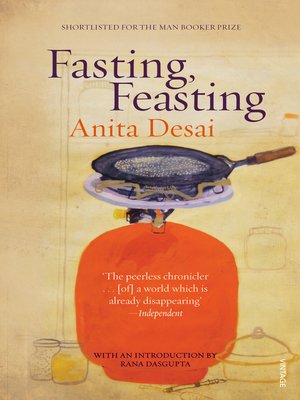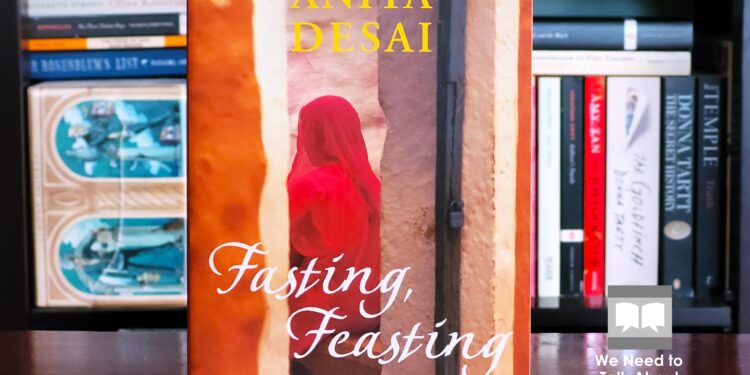Table of Contents
ToggleIntroduction
Fasting, Feasting Summary By Anita Desai Fasting, Feasting (1999) by Anita Desai is a rich exploration of family, culture, and the contrasts between personal aspirations and societal expectations. The novel tells the story of two siblings, Uma and Arun, whose lives illustrate the tensions between self-realization and the restrictive demands of family, tradition, and society. The narrative contrasts their lives in India and America, underscoring themes of isolation, repression, and yearning for freedom. The novel weaves together two main plots: one concerning Uma’s life in India under the rule of her traditional family, and the other following Arun, who has traveled to the United States to study, yet finds himself just as trapped by emotional isolation and cultural dislocation. Desai examines issues of gender, cultural identity, and the emotional toll of familial duty.
Summary of Fasting, Feasting by Anita Desai
Fasting, Feasting by Anita Desai is a poignant exploration of the lives of two Indian families and their experiences with love, duty, and cultural expectations. The novel juxtaposes the lives of a brother and sister, Arun and Uma, whose stories unfold across two distinct settings—one in India and the other in the United States. It examines themes of personal freedom, family dynamics, the role of women in traditional societies, and the complexities of cultural identity.
Part I: The Indian Family
The story begins in a small town in India, where Uma is the protagonist. Uma is a middle-aged, unmarried woman living with her overbearing, traditional parents. Her family consists of her father, a stern and self-righteous man who works in government service, and her mother, a deeply religious woman who is preoccupied with maintaining familial and social propriety. Uma’s parents view her as a failure because she has not yet married, and they are constantly reminding her of her “duty” to find a husband.
Uma, however, is not interested in marriage and desires an education and independence, which was rare for women in her society at the time. As a child, she was sent to a convent school by her father, but her education was cut short when she was forced to return home to care for her family. Throughout her life, Uma has been burdened by her family’s expectations, which limit her opportunities and freedoms.
Her mother, particularly, views Uma’s independence as a form of defiance, and the pressure placed on Uma to conform to traditional female roles leads to feelings of inadequacy and frustration. The family dynamic is tense, with Uma trapped between her desire for freedom and her familial obligations. Her parents are too preoccupied with their own notions of duty to understand Uma’s aspirations.
In contrast to Uma’s longing for independence, her brother Arun represents a different aspect of family life and expectations. Arun, who has left India to study in the United States, is portrayed as a more passive character. Arun’s education abroad is supposed to represent the fulfillment of his father’s dreams, yet he, too, feels alienated and disconnected from his family and his heritage.

Part II: Arun’s Life in the United States
Arun’s story introduces readers to a stark contrast between the familial struggles in India and the individualistic culture of the United States. While Arun enjoys the freedoms of living abroad, he is overwhelmed by the isolation and loneliness of his new life. He is an introvert, largely detached from the people around him, and experiences the alienation that often comes with being a foreigner in a new land.
Arun is also placed in a situation where he has to navigate his cultural identity. He is hosted by a well-meaning but flawed American family, the Pattons, who are unaware of the deep cultural divide between their own world and his. The Pattons’ household is chaotic and disorganized, which stands in sharp contrast to the rigid discipline of Arun’s upbringing. Arun becomes a passive observer of their lives, much as he was in India, where he never really played an active role in his family dynamics.
The Pattons’ home is filled with excessive consumption and indulgence, and it is during his time with them that Arun’s own sense of deprivation becomes most pronounced. The excess in their lifestyle is depicted through their eating habits, which are portrayed as a metaphor for the overabundance and excesses of Western culture. In comparison, Arun’s life in India—especially under the strict control of his parents—was marked by the absence of pleasure, especially related to food. This dynamic is explored further as Arun tries to make sense of his new life and the values he was raised with.
Arun’s relationship with the Pattons is distant, and he becomes increasingly more withdrawn, unable to fully engage with the people around him. His growing sense of isolation mirrors Uma’s struggles at home in India, where she too is cut off from the life she desires. Both characters are trapped in their circumstances—Uma by her family’s expectations and Arun by the cultural and emotional dislocation that comes from being away from home.
Part III: Uma’s Struggles at Home
Back in India, Uma’s life is marked by a series of events that further entrench her into her familial role. Uma is caught in a web of personal and familial obligations, forced to care for her aging parents and to tolerate their unrelenting expectations. When Uma’s parents attempt to marry her off to various suitors, she is consistently rejected, which leads to further resentment and feelings of failure.
One of the pivotal moments in Uma’s life occurs when she is introduced to a man named Anamika. Anamika, a teacher, becomes a symbol of the different ways women can navigate society. Though Uma is initially fascinated by Anamika’s independence and charm, her brief relationship with the woman is one of misunderstanding, and Anamika’s sudden departure leaves Uma feeling even more isolated.
The novel also explores Uma’s role in her family’s household, where she must balance the demands of her parents with her own sense of self. She is constantly required to suppress her desires and to take on more caregiving responsibilities. This dynamic creates a sense of emotional and physical depletion in Uma. She is a woman caught between two worlds—the traditional expectations of her family and the emerging sense of individuality that she can barely grasp but yearns for.
Read More
Part IV: The Parallels Between Arun and Uma
The novel ultimately reveals that the struggles of Arun and Uma are closely linked, despite their physical separation. Both characters are prisoners of their respective environments—Uma is confined by her family and the rigid structures of her society, while Arun is trapped in a sense of emotional detachment and alienation from his own cultural identity.
While Arun has the opportunity to escape to the United States, his experience there is not liberating, but rather reinforcing his emotional isolation. Similarly, Uma, despite her confinement in India, remains emotionally detached from her family and society. Both characters are denied the opportunity to live fulfilling lives, bound by the expectations of those around them and their inability to reconcile their own desires with those expectations.
Themes and Symbolism
One of the key themes of Fasting, Feasting is the idea of fasting and feasting as metaphors for the conflicting desires and values in the characters’ lives. For Uma, fasting represents self-denial and sacrifice—she is constantly expected to suppress her desires and live for the sake of her family’s expectations. In contrast, the Pattons’ feasting symbolizes the indulgence of the West, where excess and pleasure dominate. Arun’s alienation and detachment serve as a counterpoint to this excess, as he distances himself from the materialism of the West, yearning for something deeper and more meaningful.
The idea of family is central to the novel, and it is portrayed as both a source of support and a system of control. The characters’ relationships with their families—whether in India or the United States—are complex and fraught with tension. The novel highlights the impact of family dynamics on personal identity and the limitations that family obligations can impose on individual desires.

Conclusion
Fasting, Feasting is a deeply introspective and sensitive novel that paints a vivid picture of the tension between tradition and change, the struggle for personal freedom, and the often painful choices that individuals must make in order to fulfill their duties to family and society. Through the lives of Uma and Arun, Anita Desai explores the emotional and psychological impact of cultural and familial expectations on the individual. The novel leaves readers reflecting on the difficulties of reconciling personal desires with the responsibilities imposed by those around them.
Read More
(FAQs)
1. What is the significance of fasting and feasting in the novel?
The metaphors of fasting and feasting are central to the novel’s exploration of the characters’ internal struggles. Fasting represents self-denial, suppression of desires, and the fulfillment of familial or societal expectations. In contrast, feasting symbolizes indulgence, excess, and a life of materialism. These contrasts are embodied by the characters of Uma and Arun—Uma is forced into self-denial by her family, while Arun observes the excess of Western culture, yet feels isolated and detached from it.
2. Why is Arun distant from his host family in the United States?
Arun’s distance from the Patton family reflects his emotional isolation and the cultural divide between him and his host family. Despite being physically removed from his family in India, Arun struggles to connect with those around him due to his deep sense of alienation, both from his cultural roots and from the new, chaotic world he encounters in America. His passive role in the Pattons’ household further underscores his sense of detachment and dislocation.
3. How do family expectations affect the lives of the characters in the novel?
Family expectations are a major force in shaping the characters’ lives. Uma is constantly burdened by the expectations of her parents, who insist she conform to traditional gender roles and marry. Arun, while physically distant from his family, is still deeply affected by the weight of his family’s aspirations for him. Both characters’ struggles highlight how deeply ingrained cultural and familial expectations can limit personal freedom and self-fulfillment.
4. What role does gender play in the novel?
Gender plays a critical role in the novel, particularly in Uma’s life. Her family’s expectations are rooted in traditional views of women’s roles in society, where women are expected to marry, raise children, and serve their families. Uma’s desire for independence and her inability to conform to these expectations create tension and frustration. The novel also touches on the ways in which gender expectations are internalized, as Uma’s sense of self-worth is tied to her ability to meet these familial and societal demands.
5. What is the central message of Fasting, Feasting?
The central message of Fasting, Feasting revolves around the tension between tradition and personal freedom, the emotional isolation caused by cultural and familial expectations, and the challenge of reconciling individual desires with societal norms. Through the lives of Arun and Uma, Desai emphasizes the complexity of human emotions and the difficult choices individuals must make in navigating their relationships with family and society.

















